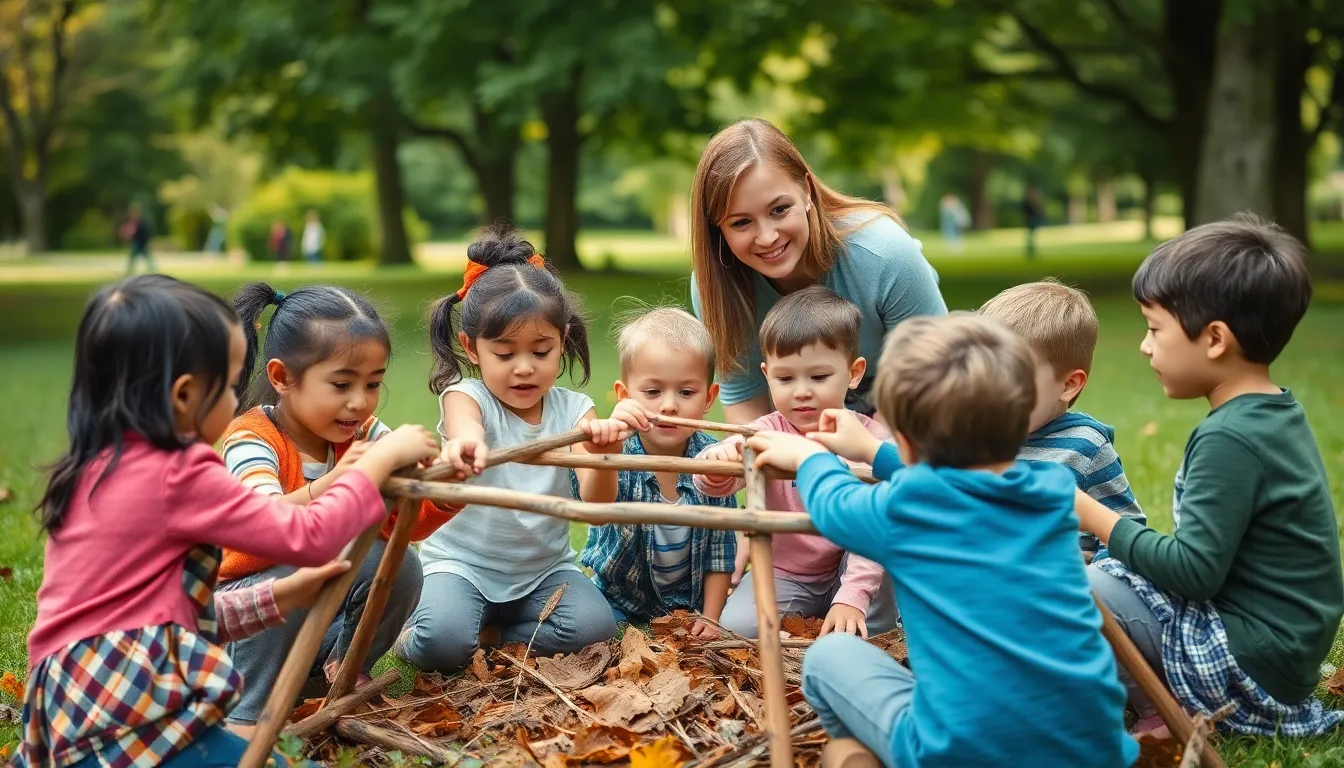In a world where parenting often feels like a chaotic circus, creative parenting emerges as the ringmaster, transforming everyday challenges into delightful adventures. Imagine turning a simple grocery run into a treasure hunt or bedtime into a thrilling storytime expedition. It’s not just about keeping kids entertained; it’s about sparking their imagination and fostering a love for learning that lasts a lifetime.
Creative parenting isn’t just a trend; it’s a lifestyle choice that encourages parents to think outside the box. By embracing creativity, parents can connect with their children on a deeper level while navigating the ups and downs of family life. So grab your invisible cape and get ready to explore fun, innovative strategies that will not only make parenting a joy but also help raise curious, confident kids. After all, who said parenting can’t be a little bit wacky?
Table of Contents
ToggleUnderstanding Creative Parenting
Creative parenting transforms daily routines into engaging experiences. This approach fosters children’s imagination while strengthening parent-child bonds.
Definition and Importance
Creative parenting embodies innovative techniques to enhance childhood experiences. It encourages parents to shift perspectives, turning distractions into learning opportunities. Emphasizing creativity nurtures curiosity in kids, enabling them to express themselves authentically. This method enriches family life, making challenges more manageable. Engaging in imaginative play promotes cognitive and emotional development. As a result, children grow into resilient, adaptable individuals, equipped to navigate life’s complexities. Creative parenting also cultivates a supportive environment where curiosity thrives and lifelong learning becomes a shared family value.
Key Characteristics
Key characteristics define creative parenting. Flexibility allows parents to adjust activities for engagement. Imagination reigns supreme, with parents inviting creativity in daily tasks. Empathy strengthens connections, ensuring parents tune into children’s emotions and needs. Encouragement of exploration fosters independence, allowing kids to learn through trial and error. Problem-solving turns obstacles into adventures, motivating children to think critically. Open communication enhances trust, creating an atmosphere where children feel safe to express their ideas. These elements combine to create a parenting style that nurtures not only creativity but confidence and curiosity in children.
Benefits of Creative Parenting

Creative parenting offers numerous advantages that significantly impact children and family dynamics. It actively promotes child development while enhancing family connections.
Enhancing Child Development
Engaging children in imaginative activities fosters cognitive growth. These experiences stimulate creativity, allowing kids to explore concepts actively. They develop language skills as they describe their ideas. Imaginative play boosts emotional intelligence, helping children understand and express their feelings. Furthermore, creative parenting encourages physical activity through games that combine fun and fitness. Parents notice that these interactive strategies lead to increased confidence and independence in their children. Children learn to embrace challenges and adapt to new situations, essential skills in today’s world.
Fostering Problem-Solving Skills
Creative parenting nurtures critical thinking and problem-solving abilities. Parents present challenges that require inventive solutions, promoting analytical skills. Children learn to assess situations and experiment with different approaches. Active participation in unique problem-solving scenarios enhances resilience when faced with obstacles. Adopting creative strategies allows kids to think outside the box, fostering innovation. Parents observe that this method helps children tackle real-world problems effectively. Overall, creative parenting equips kids with the tools they need to navigate life’s challenges confidently.
Techniques for Creative Parenting
Creative parenting employs various techniques to enrich everyday experiences. Two prominent methods include encouraging imaginative play and integrating art and creativity.
Encouraging Imaginative Play
Imaginative play serves as a cornerstone for fostering creativity in children. Parents can create an environment where pretend play thrives, such as transforming a living room into a pirate ship or a jungle. Storytelling holds great potential; incorporating characters and plots encourages children to develop their storytelling skills. Providing props, like costumes or everyday household items, can spark innovative role-playing scenarios. Outdoor activities, such as building a fort or playing in nature, promote exploration and creativity. Children gain confidence and resilience when parents actively participate in these imaginative adventures, deepening the parent-child bond.
Integrating Art and Creativity
Art integration plays a pivotal role in promoting creative expression. Parents can introduce various forms of art, such as painting, drawing, or crafting, to enhance children’s artistic abilities. Setting up an art station stocked with diverse supplies ignites inspiration. Joining children in the creative process fosters collaboration and imaginative thinking. Emphasizing the importance of free expression helps children explore their emotions and ideas through their artwork. Taking trips to museums or art galleries exposes children to different styles and cultures, enriching their understanding of creativity. By prioritizing artistic exploration, parents nurture a lifelong appreciation for creativity in their children.
Challenges in Creative Parenting
Creative parenting offers unique challenges that require thoughtful strategies.
Overcoming Societal Expectations
Societal norms often dictate how parents should raise their children. Parents face pressure to conform to traditional parenting styles. They must navigate expectations around discipline, education, and activities. Innovative approaches may not align with these standards, leading to feelings of doubt. Some parents may feel judged for their creativity, fearing it might conflict with what others deem appropriate. Open discussions about parenting choices can help alleviate this stress. A supportive community provides encouragement, reminding parents that every family’s journey is distinct.
Balancing Structure and Freedom
Establishing a balance between structure and freedom remains crucial in creative parenting. Parents strive to provide a secure environment while allowing flexibility for exploration. Rigid schedules can stifle creativity, while complete freedom may lead to chaos. Parents might implement routines that offer stability without compromising imaginative play. Setting aside time for free exploration encourages children to discover their interests. Providing guidelines helps children feel secure while fostering their creativity. Striking this balance ultimately enriches children’s experiences and nurtures their growth.
Creative parenting isn’t just a method; it’s a mindset that transforms everyday moments into extraordinary experiences. By embracing imagination and flexibility parents can foster an environment where children thrive emotionally and cognitively. This approach not only strengthens family bonds but also equips kids with the skills they need to face life’s challenges confidently.
As parents navigate the complexities of raising children they can find joy in the journey by turning routine activities into engaging adventures. The benefits of creative parenting extend far beyond the immediate family dynamic. They lay the foundation for a generation of curious and resilient individuals ready to explore the world with open minds and hearts.




